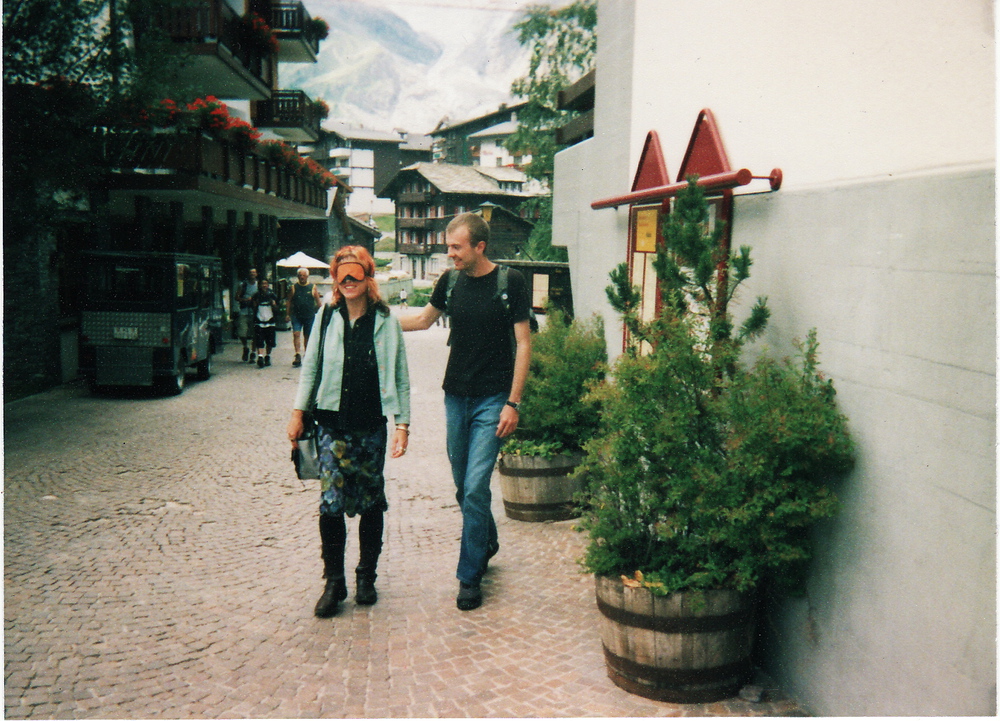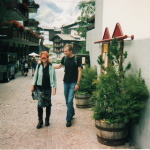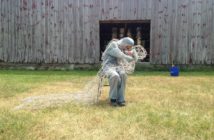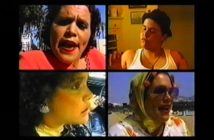Anyway, if it wasn't for J. L. and John S., I would have not have had as wide a sense of how meaning can be made in the world. The big thing that these guys turned me on to was how sometimes language and action are exactly the same thing. Like when I say "Can I take your coat?", I am not actually taking your coat by saying it, but when I say "Let me introduce you to. . ." the phrase and the act that it refers to are identical. Just like when you say "I promise to. . ." or when your last will and testament says "I bequeath. . .". These bits of language behave a little bit differently than the other kinds of language that we use—though J.L. and John S. spent all of the mid-1990s trying to convince me that all language bears traces of this dynamic, or implies it to varying degrees.
After college, particularly in graduate school, I found their ideas limiting or maybe limited is a better word. Still, if I hadn't known them back then, I would not have understood language as a site for literal action—action as in motion, not just resolve to act.
Another friend of mine from those days, Ludwig Wittgenstein, took this to a more elegant level for me with the final few bits of his famous Tractatus [pdf].3 He helped me to recognize language for the first time as something that could be used like a springboard—a diving board—to jump off of into spheres where words don't apply at all. Once I saw that this could be done I leapt—and continue to leap—away from language and deep into viscosity, texture, crumbling handfulls of earth, shattering glass, the reek of stale urine, melting hotglue, bright flashes of color and light, squealing amplifiers, sawdust, rotting fruit, the slamming of bodies against bodies, sweat, growling, lice, blisters, salt.
But then I'll surface abruptly from the idyllic state of immersion in practices of various types. I'll find myself with a pen in hand and with questions I want to take notes on. That's how we wind up here, you and me, on either side of these particular words.

Before I go on, I want to throw On Kawara into the mix of ideas about how language can be used. Kawara and I did not become acquainted until well after the notion of a formal education had arisen and dissolved for me again into real life. His quiet ways and present non-presence eluded my awareness by being steady in the center of it rather than moving into or out of its frame. It crept up on me after repeated exposure, but then I became profoundly aware of how much he could contribute to my understanding of the potency of language for documenting experience without letting it die on the page. The trick of making text really useful (he helped me to understand) is to undermine it at every single turn. Head language off at the pass, and you can keep it meaning. Which is the real struggle. His most interesting moves for me now are those that swim off of the canvas or telegram or whatever. For example his choice to have both volumes of One Million Years read aloud for One Thousand Days One Million Years4 and whatever impulse drove him to move some of his Today Series into kindergartens for Pure Consciousness . . .

Which leads me to my main concern here: I am interested in the moments or locations where gesture, action, or non-verbal sound gets exchanged for words within creative practices and vice versa. This is huge ground to cover, so I'm just going to play hopscotch on the squares that interest me at the moment.
First I want to talk about Bob Dylan's Homesick Subterranean Blues as performed in D.A. Pennebaker's DONT LOOK BACK. This is arguably the first music video, but back when it was filmed, synch sound in documentary contexts was a pretty new idea. New as in still being tested by Pennebaker (along with Ricky Leacock at MIT). New as in when DONT LOOK BACK was made they were still using mic capsules in hollowed out Bic pens taped to the camera handle for a directional effect. Pennebaker was using one of the earliest (prototype?) synch sound cameras when he shot DONT LOOK BACK, but it's obvious that the music is edited in to this sequence. So why is Dylan so synched to the footage in terms of gestural timing, but not always in terms of the text? Also, why does he look so disconnected from what he's doing as he "cinescopes" his homemade, sometimes accurate, sometimes punny cue cards? This key historical moment where music, text, and gesture captured via moving image all come together without narrative (for the first time ever?) is filled with an incredible amount of ambiguity about that conjunction.
Making matters worse is Allen Ginsberg's cameo appearance—off to the left of the frame and then walking across the screen at the end.
As one of the grandfathers of spoken word poetry (which eventually begat another medium tautly stretched between language and performance: slam poetry) he reads like a walking representation of spoken language—relegated to the sidelines so that written language can be featured. But then it is featured with such anxiety! The aspects most foregrounded here are the effort involved in retaining the synch between the sung language in the music, the written language on the cards, and the gesture of throwing the written language away as quickly as possible while trying to keep it all organized.
Spoken word, in the form of Ginsberg walking across the frame after Dylan leaves, has "the last word" so to speak (and it's also ultimately the thing that the written text is trying to keep pace with). But finally it is gesture—the motion and action of the body in space—that frames everything the camera is covering. The body's gestures and actions are the punctuation of this "music video." The scene begins with a zoom out from what is ostensibly Dylan's discarded jacket taken off to permit as much upper body movement as possible, and the piece ends with walking: With three walkers going in three different (cardinal?) directions, forward, backward and across. It feels like a spell of some sort. . .
Writing this, I suddenly remember a photograph I once took of writer-artist Shelly Jackson walking on a very bright day down a slight incline with a blindfold on, guided by a friend or colleague. I just happened to see them and thought it would make an interesting photograph, so I snapped it as I walked by, not realizing until later in the day, when I went to hear her talk, that it was her. I have no idea why she was doing this—perhaps even as favor to the person who was walking with her rather than for her own purposes—but the gesture, like the image, struck me. It stayed deeply embedded in my psyche as an action undertaken by someone so entwined in language that an extraordinary effort had to be made in order to remain embodied and alert to nature.

And Jackson's writings are of course both of these things. From her most famous work, the novel-in-progress Skin,5 tattooed word by word across the world, keeping her text from settling anywhere in space or time, to her most recent story Snow,6 which eludes the permanence of most written language by being written, as weather permits, in snow.

What can performance and language can offer each other? Why is it that some people can't simply write or simply perform? Why do they feel the need to do both? And how does the movement between language and action deepen, enhance, challenge, strengthen, weaken, break, expand, and diminish each practice?
Perhaps the best place to go next here is to performance artist Guillermo Gómez-Peña's essay, "In Defence of Performance Art".7
"Our scars" Gómez-Peña says, "are involuntary words in the open book of our body, whereas our tattoos, piercings, body paint, adornments, performance prosthetics, and/or robotic accessories, are de-li-be-rate phrases." This image—of text written in a way that alternates between the involuntary mark and the intentional one—is a lovely one for getting at two subthemes here: the space within language that performance can inhabit and potentially reshape, and the body's inseparability from language. Add these two subthemes together with a moment-to-moment enacted consciousness of them, and you get something veering towards ritual. The body makes and lives in language; the body moves and displaces space. The body can impact the content and form of what it produces.

Gómez-Peña sees the body as site of language but also makes a sharp distinction between performance art and other types of performance that involve texts. "In most theater practice based on text, once the script is finished, it gets memorized and obsessively rehearsed by the actors, and it will be performed almost identically every night. Not one performance art piece is ever the same. In performance, whether text-based or not, the script is just a blueprint for action, a hypertext contemplating multiple contingencies and options, and it is never 'finished.' Every time I publish a script, I must beware the reader: 'This is just one version of the text. Next week it will be different.'"
And finally, he reminds us "Most performance artists are also writers, but only a handful of us write for publication. We theorize about art, politics and culture, but our interdisciplinary methodologies are different from those of academic theorists. They have binoculars; we have radars . . . We chronicle our times, true, but unlike journalists or social commentators, our chronicles tend to be non-narrative and polyvocal."
In a conversation with Boston-based performance artist, writer,8 and curator9 Sandrine Shaefer10 about how much of her work involves writing, she admitted that across the multiple practices, the percentage of writing to other types of activity within them is along the lines of about 50%. When we talk about writing specifically—what percentage of writing is actually writing—there is a pregnant pause and then we both laugh. I'll come back to this.
I ask her "How do you know when you're writing?" and she answers "I feel like when I'm writing and I'm writing something I want to be writing or that I feel good about as a piece of writing there is this kind of—this is going to sound so cheesy—but it's like an altered state. And it's similar I guess to the way I feel when I'm making performance. But that doesn't always happen." "I used to try to be very regimented—when I had a deadline I'd sit down for an hour a day every day . . . but that doesn't work for me . . . If I'm not feeling it, I can't do it. But then I'll sit there and I'll write for eight hours at a time and completely lose track of that time. Which is exactly how my performances work—I set myself up so that I can do that in performances too. So I guess that's how I know that I'm writing."
She knows that she's writing because she's just written.
Sandrine and I also talk about written and spoken language in the context of performance, and vocalization in performance as opposed to articulate speech. We talk about whispering—which we had both just used in different ways in recent art works—its pleasant sound- texture and the intimate interactivity it provokes. And we discuss the boundary that is thrown up when working internationally if you use language that someone else does not understand.
For Sandrine, a lot of performance involving vocalization—singing, whispering, speaking—is rooted in an effort to overcome or exorcise fears of doing those things in public.
We talk about how much of writing is not writing . . .
When you write, you are sitting in front of the computer or typewriter or with a pen in hand and not writing at all for weeks at a time sometimes. In those moments, are you writing, performing as a writer, or is it something else? I think of it as conjuring—a process that involves reading, reading, reading, reading, staring at a text and realizing that you're not reading, writing, erasing everything that you just wrote, staring at a wall, trying not to stare at a wall, opening a window, closing a window, making toast, making tea, checking your phone to see if there are any text messages, stretching, walking to the mailbox, sitting, staring at a wall, trying not to stare at a wall, not writing, hating yourself, telling yourself to get your shit together, making more toast, throwing yourself into a heated debate on Facebook, re-reading something that you wrote a long time ago and deciding to edit it completely, surfing the internet for a good deal on self-inking rubber stamps, weeding, filing old bills, washing dishes, staring at a screen, typing one letter over and over again, doing pushups . . .
When I read this description of 'conjuring up writing' back to myself I realize it could easily be plopped into a blog or catalog documenting a night of performances without seeming at all unnatural. In fact, what you have above is a partial documentation of a performance that I made while developing this piece of writing. The documentation is incomplete because you wouldn't want to read it in real time. The performance occurred in several variations for a few hours every few days day for about three weeks. It occured for about 48 hours straight in its final days.
And in many ways the act of conjuring is what writing and performance art share.
For Scotch Wichmann,11 performance artist and author of what claims to be the first performance art novel, Two Performance Artists Kidnap Their Boss and Do Things With Him,12 "writing" and making performance art feel like distinctly different things.
"I felt like a writer when writing articles, short stories and the like, with a focus on delivering clear throughlines of thought on the page with the typical grammar, syntax, and structures expected by readers. When I'm working on a performance art piece, by contrast, I don't 'feel' like a writer; I don't really think of the writing as separate from the other elements in the performance—the use of objects, sound, physical movement, etc. Words are used for their literal meaning, but also for their formal qualities. In that mode, I see myself as 'generating' text (as opposed to crafting it), which feels no different than, say, choreographing how I might drag a fish across the floor. I don't hold myself to any strict grammatical, syntactical, or stylistic rules, except for whatever is appropriate for the piece, freeing me up to allow the elements to inform each other, and hold dialogs with my subconscious. The hissssss of a fish being dragged across concrete might suddenly seem to contrast best with text that's heavily assonant—that is, the physical action helps 'write' what text should accompany it."
But, he admits . . . "The novel being a 'performance art novel,' I couldn't help but use performance art techniques for content development. Most of the book's characters are given subtle 'performance arty' moments—a gallery curator pulls a videotape out of his pants, for example—and I wrote these in the way that I would perform them; in that respect, coming full circle, I felt at times like the characters were performing me. . . . I used the same brainstorming techniques to develop the protagonists' performances that I use to make my own pieces . . . and although novels are typically written in the past tense, I chose to write all of the performances in the present. For me, performance always unfolds in the now (although it certainly has the power to magically retrieve and bring other timeframes to the fore)."
This is definitely new territory—a fictional narrative on paper13 driven by performance art impulses, but Wichmann's rationale for taking pen in hand is firmly rooted in the spirit of performance art. "Somebody needed to capture the intensely creative world that performance artists inhabit, and their radical working methods that allow them to regularly create brand new art forms." He felt that a fictional narrative could do something that just performing couldn't: reach audiences that don't seek out performance art. He wanted "others to see performance art for what it is: a kind of punk rock, shamanic way of thinking in which nothing is ever discarded, and whereanything—a hole in the ground, a pig bladder, or even a mistake—can be used to magically and ferociously change how people see the world and their place in it."
Finally, I want to address a concept out there that I've come in contact with outside of the US but which isn't much of a phenomenon here: a genre of performance art known as Performance Writing. The performance writing movement sees language as an event. It has roots in visual poetry, but now encompasses varieties of performance art, which uses a lot of language as a tool or method. For a field that is interested in language and has a lot of conferences and festivals, there is very little in the way of literature describing the idea. A loose keynote talk given by one of the founders of this relatively young field, artist-writer Caroline Bergvall,14 in 1996 "What do we Mean by Performance Writing?" [pdf]15 is one of the main texts defining it. And it works hard to avoid defining it too definitively.
"The contemporaneity of the notion of Performance Writing is that it can only locate itself as part of the atomization of literature, music, theatre and so on. . . . rather than entertaining ideas of aesthetic orgy or formal fusion, anything goes as long as there's a bit of something which looks like writing in it and leaving it at that, my sense is that Performance Writing would wish to inscribe itself within debates that revel in conflict. Conflict at a formal as well as an ideological level . . . Performance Writing would be about detail. A close attention to the workings, the sitings and the political dimensions . . . whether on or beyond the page. . . . Perhaps I could sketch it out in terms of process. What is the process of live performance in its relation to writing? Is it writing's role, in that context, to function as a guiding background, as the blueprint of a live piece? This would mean that the text remains absorbed, subsumed by the live performance. What if the writing were to openly interfere with the live piece? What if it were to force a disjunction between performing a hidden text and performing writing? Can one turn the hour-glass and argue for the specificities of a live writing (I use the term with caution) where the performer's presence is cut open, emptied out, absented by the writing's own presencing (mise-en-presence), much like late-Beckett, The Wooster Group, Laurie Anderson, Forced Entertainment's Speak Bitterness would seek to instigate. I remain excited by this idea of a live situation where writing is another performer and as such needs to be addressed explicitly. During and as part of the live piece."
"Ok, writing" I'm thinking to myself here now, "Do you—as something somehow separate from me—want to be a part of this discussion? Do you want to have the last word here? I'm game for giving it to you. Just say whatever you want to say—I'm willing to give you free use of my funny plastic-metal keyboard thing here and use of my finger-muscles and hand eye coordination as long as you stop doing that weird flappy thing with my left index finger."
(Long, L-O-N-G pause.)
No, writing doesn't have anything it wants to say. It seems writing just wants to listen to some music.16
Tara Jane O'Neil - Wordless In Woods (Stereogum Premiere) from stereogum on Vimeo.
- Image from Shelly Jackson’s Snow poem.
- Writer-artist Shelly Jackson walking on a very bright day down a slight incline with a blindfold on
- On Kawara, DEC. 24, 1978, Acrylic on canvas, 1978. from “Today” series, 1966- 8 x 10 inches (20.3 x 25.4 cm) KAWON0446
- Installation view of Pure Consciousness at Packer Collegiate Institute, Brooklyn, New York, in 2008 On Kawara, Pure Consciousness (JAN. 1, 1997 — JAN. 7, 1997), Acrylic on canvas, 1997 from “Today” series, 1966- 7 paintings JAN. 1, 1997: 8 x 10 inches (20.3 x 25.4 cm) JAN. 2, 1997: 10 x 13 inches (25.4 x 33 cm) JAN. 3, 1997: 8 x 10 inches (20.3 x 25.4 cm) JAN. 4, 1997: 10 x 13 inches (25.4 x 33 cm) JAN. 5, 1997: 10 x 13 inches (25.4 x 33 cm) JAN. 6, 1997: 8 x 10 inches (20.3 x 25.4 cm) JAN. 7, 1997: 10 x 13 inches (25.4 x 33 cm) KAWON0129
[1] Austin, J.L., How To Do Things With Words: The William James Lectures Delivered at Harvard University in 1955. (Cambridge, MA: Harvard University Press, 1975.)
[2] Searle, John R., Speech Acts: An Essay in The Philosophy of Language. (UK: Cambridge University Press, 1999.)
[3] http://www.gutenberg.org/files/5740/5740-pdf.pdf
[4] Dear Anyone Who is Reading This Who Has the Political Power to Fulfill this Wish: I would very much like to PoMo it up someday by listening to On Kawara's One Thousand Days One Million Years while simultaneously watching Christian Marclay's The Clock. If you are reading this and happen to work for something that functions like the Make A Wish Foundation but isn't for people who are dying (knock on wood) please get in touch!
[5] http://ineradicablestain.com/skindex.html
[6] http://instagram.com/snowshelleyjackson#
[7] http://www.pochanostra.com/antes/jazz_pocha2/mainpages/in_defense.htm
[8] http://www.bigredandshiny.com/cgi-bin/BRS.cgi?view=archive&v=1&start=1&s=Sandrine+Schaefer&bA=&inc=50&sort=1&field=3&match=1&aAuth=1
[9] Or rather "experiential artist." Within our conversation we discussed the need to arrive at more encompassing terminology for creatives with a multitude of intertwined practices and this is what she arrived at for her naming the whole of her different types of work.
[10] http://sandrineschaefer.com/home.html and http://www.sandrineschaefercuratorial.com/
[11] http://www.scotchwichmann.com/
[12] (Hollywood, CA: Freakshow Books, 2014.)
[13] Maybe Alejandro Jodorosky's Holy Mountain, for example does something along these lines on film?
[14] http://www.carolinebergvall.com
[15] http://www.carolinebergvall.com/content/text/BERGVALL-KEYNOTE.pdf
[16] Special thanks to Tara Jane O'Neil who inadvertantly helped me formulate some of these ideas during a short, informal conversation about her song Wordless In Woods.









